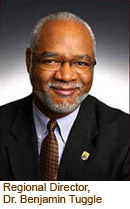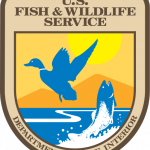How the Conservation Plan for the Dunes Sagebrush Lizard Works

Photo Courtesy of the U.S. Fish and Wildlife Service.
The Dunes Sagebrush Lizard is being kept off of the endangered species list. For now.
The dunes sagebrush lizard is tiny, and brown, and hides in the dunes of East New Mexico and West Texas. And until recently, it seemed like it could threaten the drilling boom in the Permian basin as the U.S. Fish & Wildlife Service considered adding the lizard to the endangered species list.
But this week the oil and gas industry breathed a huge sigh of relief when it was announced that the lizard won’t be added. Thanks to a conservation plan brought forward by stakeholders in the region and approved by the state comptroller, Fish & Wildlife was convinced that the lizard would be just fine.
But how does the plan work? And what about it convinced Fish & Wildlife that it would be enough to save the lizard? For some answers, we turned to Dr. Benjamin Tuggle, the Southwest Regional Director for Fish & Wildlife.
Q: What is it about the Texas conservation plan that led to the lizard not being listed by the Fish and Wildlife Department?
A: Well, I wanna go back to where the habitat is. About two-thirds of the habitat was in New Mexico, and about one-third was in Texas. And we had the candidate conservation agreements and candidate conservation agreements with assurances that covered over 90 percent of the habitat that is in New Mexico. The remaining one third of that habitat that was critical for the survival of the species and also for the long-term sustainability of the species didn’t have any protection at all in Texas, and it was all on private lands.
And so we determined through our scientific analysis that that part of the population was very important for the long-term sustainability of the species, and we needed to get a candidate conservation agreement with assurances, which are the agreements that we provide for private lands established in Texas so we’d the same level of protection across the landscape.

PHOTO COURTESY OF THE U.S. FISH AND WILDLIFE SERVICE
U.S. Fish and Wildlife Service says Dunes Sagebrush Lizard should not be considered endangered.
Q: Can you explain what a candidate conservation agreement is?
A: Candidate conservation agreement basically is a voluntary agreement process that brings people to the table that could potentially have operations on the landscape that could impact lizard habitat. And they sign on to these agreements, voluntarily of course, to do different conservation measures that won’t impact the long term sustainability of the species nor impact the habitat. And so these agreements are basically agreements that, whether they are private landowner or gas and oil company, that identifies up front avoidance of those habitats where the species lives. Also, a fee system that puts in place opportunities to provide other restoration habitat so that the species can distribute across the landscape.
And part of that agreement, what the companies or the private landowners get, is the assurance from the Fish and Wildlife Service that this is all it will take to get this work done. So the Fish and Wildlife Service will not come back and say, ‘okay, you’ve done x, y. It was enough last year, but now you need to do z. And that’s the assurances part. Because they’ve committed to doing these conservation goals, objectives, and standards, then that’s all they’ll have to do.

Photo courtesy of USFWS
Dr. Benjamin Tuggle, Regional Director for the U.S. Fish and Wildlife Service Southwest Region
Q: Can you give us some examples of what those conservation measures might be, depending upon the type of land use?
A: Probably the biggest one is avoidance. They will avoid any impacts to those blow out dunes and swales where the habitat is for the lizards. One of the things we found out that the industry can do is drill directionally, and it doesn’t mean that they cannot drill for oil underneath those habitats. They simply will create their paths in areas where there is not lizard habitat. Then they’ll drill directionally to get those gas and oil resources that they’re trying to bring to market. What we’re talking about is avoiding putting things like caliche pads and other types of infrastructure like oil pipes or things like that directly in the habitat itself. So avoidance is probably one of the biggest ones.
I think that also from the standpoint of how it is we look at those conservation goals and objectives, it very much is part of an overall strategy to also monitor what’s happening in those areas to make sure that those goals and objectives are not only being met but being effective.
Q: And what measures are ranchers taking?
A: Probably on the ranchers’ part the biggest thing is to try to get rid of mesquite. What mesquite does is that it puts down deep roots and prevents those blow out dunes and swales from forming. Therefore, it eliminates the habitat for those lizards. Most ranchers are more than happy to get rid of mesquite primarily because it has a diminishing effect on their ability to graze. If a rancher is grazing those properties, there’s incentives that are built in to some of the agreements and through some of the fees that are actually being paid that incentivize the rancher to go in and take out the mesquite. That’s one of the benefits of private landowners signing up in the agreements.
The grazing part of that really has a minimal effect because the cows that are grazing don’t have enough to eat in those blowouts, so they’re not going to spend a lot of time in there. And even if they’re grazing on shinnery oak…I’m told if you eat it at a particular time it’s kinda poisonous, so that’s one of the reasons why a lot the ranchers were taking out a lot of the shinnery oak. But now we recognize that shinnery oak is very important in terms of stabilizing some of those blowout dunes.
Q: Can putting the lizard on the list be revisited in the future?
A: Absolutely. The reason why we chose not to list it is because we have the kind of coverages through these candidate conservation agreements and candidate conservation agreements with assurances that we feel are going to protect the lizard and lead to long-term sustainability of that population. If the measures that we’ve designed do not accomplish those goals, then we still have the responsibility and have the option of bringing up potential listing for the lizard again. But we’re fairly confident with the commitment on the part of the people who have signed on and made commitment of resources that they’re committed to that process and so are we. And we’re pretty certain, about as certain as we possibly can be, that it will work.
Q: Is there anything else you’d like to add?
A: Whenever you talk about big gas and oil and you talk about a listed species, particularly a reptile – a little-bitty lizard – there’s always the opportunity for cynicism. There’s always the opportunity to say that big government is coming in and trying to tell us what to do, and being over-officious and regulatory. I think this is a classic example, a monumental example, of when people sit down, talk to one another, communicate what it is that they need to continue the economic development on a landscape, and have an opportunity to listen to what it is that needs to take place on that landscape to protect species of this ilk. When they get together and can reach agreement then it works. So there isn’t this situation where the government is being dictatorial. It very much is a collaborative process that everybody gets something out of. We very much would like to see that take place because it creates less of a polarizing situation between people that are trying to make a living on the landscape and the resources, particularly the species and habitat that are dependent on that same landscape.
